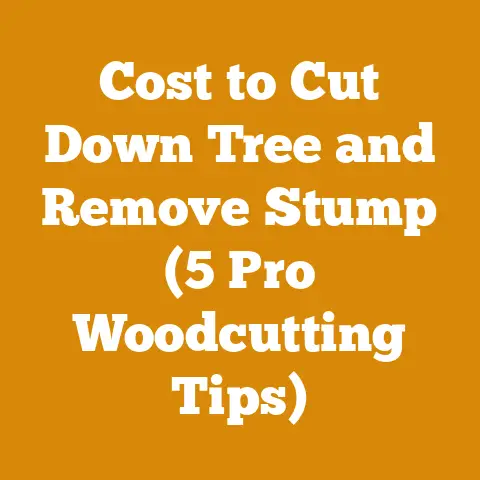Mulch from Stump Grinding: Cleanup Tips & Trade Secrets (Pro Tips)
Mulch from Stump Grinding: Cleanup Tips & Trade Secrets (Pro Tips)
Understanding the User Intent
The user is looking for practical advice and cost-effective strategies related to the cleanup and utilization of mulch created from stump grinding. They want to know how to handle the mulch efficiently, whether to reuse it, and what the potential costs and benefits are. The phrase “Pro Tips” suggests they’re seeking expert-level insights and techniques.
Stump Grinding Mulch: A Valuable Byproduct or Just a Mess?
Let’s be honest, when you envision a freshly ground stump, “beautiful mulch” might not be the first thing that comes to mind. It’s often seen as a messy pile of wood chips and soil. However, with the right knowledge and approach, that pile can be a valuable resource.
From my own experience, I’ve seen this firsthand. Years ago, I helped a friend clear a heavily wooded lot for a new home. We had a lot of stumps to grind. Initially, we planned to haul the mulch away, but the cost of disposal was eye-watering. That’s when we started exploring alternative uses and quickly realized the potential. We used it to create pathways, mulch garden beds, and even amend the soil in areas where the topsoil was poor.
Cleanup Methods: Efficiency and Cost Considerations
The first step is tackling the mound of fresh mulch. Here’s a breakdown of common cleanup methods, along with their associated costs:
1. Manual Removal (Shovels and Wheelbarrows):
- Description: This involves physically shoveling the mulch into wheelbarrows and transporting it to a designated disposal or storage area.
- Pros: Low initial investment (assuming you already own shovels and wheelbarrows), good for small areas, allows for careful separation of mulch from soil.
- Cons: Labor-intensive, time-consuming, not suitable for large volumes of mulch, can be physically demanding.
- Cost Breakdown:
- Labor: This is the biggest factor. Expect to pay between $25-$50 per hour per worker, depending on experience and location. If you’re doing it yourself, factor in your own time and physical effort.
- Equipment: Shovels ($20-$50), wheelbarrows ($80-$200).
- Disposal (if applicable): Landfill fees can range from $50-$100 per ton.
- I’ve found that for smaller jobs, like grinding a single stump, this can be cost-effective if you’re willing to put in the sweat equity. But for anything larger, it quickly becomes impractical.
2. Mechanical Removal (Skid Steer or Compact Loader):
- Description: Using a skid steer or compact loader with a bucket attachment to scoop up and move the mulch.
- Pros: Fast and efficient for large volumes of mulch, reduces manual labor, can move mulch over long distances.
- Cons: High initial investment (if purchasing equipment), rental fees can be significant, requires skilled operator, can damage surrounding landscaping if not operated carefully.
- Cost Breakdown:
- Rental: Skid steer rental typically ranges from $300-$600 per day, depending on size and features.
- Operator: If you need to hire an operator, expect to pay $50-$100 per hour.
- Fuel: Skid steers consume a significant amount of fuel. Budget for $50-$100 per day.
- Delivery/Pickup: Transportation costs for the equipment can add another $50-$200.
- Data Point: According to a report by Equipment World, the average hourly operating cost for a compact track loader (similar to a skid steer) is around $35, excluding labor.
- I once rented a skid steer for a large stump grinding project. The speed and efficiency were incredible, but the rental cost and fuel consumption quickly added up. Make sure you accurately estimate the volume of mulch before opting for this method.
3. Vacuum Truck:
- Description: Specialized trucks equipped with powerful vacuum systems to suck up loose materials like mulch.
- Pros: Extremely efficient for large volumes, minimal impact on surrounding landscaping, can reach difficult areas.
- Cons: High rental cost, limited availability in some areas, not suitable for heavily compacted mulch.
- Cost Breakdown:
- Rental: Vacuum truck rental can range from $800-$1500 per day, depending on size and distance.
- Operator: Included in the rental fee.
- Disposal: Landfill fees, if applicable.
- I haven’t personally used a vacuum truck for stump grinding mulch, but I’ve seen them used on large construction sites. They’re incredibly effective, but the cost is a major barrier for most residential projects.
4. Mulch Blowers:
- Description: Machines that blow mulch through a hose, allowing for precise placement in gardens or other areas.
- Pros: Efficient for spreading mulch over large areas, reduces manual labor, can reach difficult areas.
- Cons: High rental cost, requires skilled operator, can be messy if not used properly.
- Cost Breakdown:
- Rental: Mulch blower rental can range from $400-$800 per day, depending on size and features.
- Operator: If you need to hire an operator, expect to pay $50-$100 per hour.
- Material Cost: The cost of the mulch itself (if you’re not using the stump grinding mulch).
- Mulch blowers are fantastic for spreading mulch quickly and evenly, but they’re best suited for projects where you’re purchasing mulch separately. Using them with stump grinding mulch can be tricky due to the varying particle size and potential soil contamination.
Trade Secrets for Efficient Cleanup
Beyond choosing the right method, here are some pro tips I’ve learned over the years:
- Plan Ahead: Before you even start grinding, designate a location for the mulch. This will save you time and effort later.
- Containment: Use tarps or barriers to contain the mulch and prevent it from spreading into unwanted areas.
- Sifting: If you want to use the mulch in a garden, consider sifting it to remove larger pieces of wood and debris. A simple homemade sifter can be constructed using a wooden frame and wire mesh.
- Mixing: Mix the mulch with topsoil or compost to improve its texture and nutrient content.
- Don’t Overfill: When using a wheelbarrow or skid steer, avoid overfilling to prevent spills and accidents.
- Safety First: Wear appropriate personal protective equipment (PPE), including gloves, eye protection, and a dust mask.
- Consider the Weather: Avoid cleanup on windy days, as the mulch can easily blow around.
- Use a Tarp for Loading: When loading mulch into a truck or trailer, place a tarp in the bed first. This will make unloading much easier.
- Communicate with the Grinding Crew: Discuss your cleanup plans with the stump grinding crew before they start the job. They may have suggestions or be able to assist with the initial cleanup.
The Million-Dollar Question: To Reuse or Not to Reuse?
This is where things get interesting. The decision to reuse stump grinding mulch depends on several factors:
- Wood Species: Some wood species, like black walnut, contain compounds that can inhibit plant growth. Avoid using mulch from these trees in your garden.
- Soil Contamination: Stump grinding mulch often contains soil, which can affect its drainage and nutrient content.
- Disease and Pests: If the tree was diseased or infested with pests, the mulch may contain pathogens or insects that could harm other plants.
- Aesthetics: Stump grinding mulch can be coarse and uneven, which may not be desirable for certain landscaping applications.
Here’s a general guideline:
- Reusing is Generally Okay If:
- The tree was healthy.
- The mulch is free of visible signs of disease or pests.
- You’re using it for non-sensitive areas, like pathways or erosion control.
- Avoid Reusing If:
- The tree was diseased or infested.
- You’re using it in a vegetable garden or around sensitive plants.
- The mulch is heavily contaminated with soil.
Potential Uses for Stump Grinding Mulch:
- Pathways: A simple and effective way to create natural-looking pathways.
- Erosion Control: Mulch can help stabilize soil and prevent erosion on slopes or hillsides.
- Soil Amendment: When mixed with topsoil or compost, mulch can improve soil structure and drainage.
- Composting: Stump grinding mulch can be a valuable addition to a compost pile.
- Animal Bedding: Coarse mulch can be used as bedding for livestock or poultry.
- Playground Surfacing: In some cases, mulch can be used as a safe and natural surfacing material for playgrounds.
The Cost of Reusing vs. Disposing:
Let’s break down the costs associated with each option:
Reusing:
- Pros:
- Saves money on disposal fees.
- Reduces the need to purchase new mulch.
- Environmentally friendly.
- Cons:
- May require additional labor for sifting and mixing.
- Potential risk of introducing disease or pests.
- Aesthetic limitations.
- Cost Breakdown:
- Labor (if sifting or mixing): $25-$50 per hour.
- Sifter (if purchasing): $50-$100.
- Topsoil or compost (if mixing): $30-$50 per cubic yard.
Disposing:
- Pros:
- Eliminates the risk of disease or pests.
- Provides a clean slate for landscaping.
- No additional labor required.
- Cons:
- Can be expensive.
- Environmentally unfriendly.
- Cost Breakdown:
- Disposal fees: $50-$100 per ton.
- Transportation costs (if hauling yourself): $50-$100.
- Cost of purchasing new mulch: $30-$60 per cubic yard.
Data Point: According to the EPA, yard waste accounts for a significant portion of municipal solid waste. Reusing stump grinding mulch can help reduce the amount of waste sent to landfills.
My Recommendation:
In most cases, I recommend trying to reuse stump grinding mulch, especially if the tree was healthy. The cost savings and environmental benefits are significant. However, it’s important to carefully assess the risks and take appropriate precautions.
Case Studies: Real-World Examples
Let’s look at a few real-world examples to illustrate the cost implications of different cleanup strategies:
Case Study 1: Small Residential Stump Grinding
- Scenario: Homeowner grinds a single, healthy maple tree stump in their backyard.
- Cleanup Method: Manual removal using shovels and wheelbarrows.
- Reuse Strategy: Uses the mulch to create a pathway in their garden.
- Cost Breakdown:
- Labor (DIY): 5 hours x $0 (opportunity cost) = $0
- Equipment (already owned): $0
- Disposal fees: $0
- Cost of new mulch (avoided): $30
- Total Cost: $0
- Savings: $30
Case Study 2: Large Commercial Stump Grinding
- Scenario: Contractor grinds multiple stumps on a commercial property.
- Cleanup Method: Mechanical removal using a skid steer.
- Reuse Strategy: Hauls the mulch to a landfill for disposal.
- Cost Breakdown:
- Skid steer rental: $400 per day
- Operator: $400 (8 hours x $50 per hour)
- Fuel: $50
- Disposal fees: $200 (4 tons x $50 per ton)
- Transportation: $100
- Total Cost: $1150
Case Study 3: Eco-Conscious Landscaper
- Scenario: Landscaper grinds stumps on a residential property and prioritizes sustainable practices.
- Cleanup Method: Manual removal with sifting.
- Reuse Strategy: Uses the sifted mulch to amend the soil in garden beds.
- Cost Breakdown:
- Labor (sifting): 8 hours x $30 per hour = $240
- Sifter (purchased): $75
- Topsoil (mixing): $50
- Disposal fees (for oversized pieces): $25
- Cost of new soil (avoided): $100
- Total Cost: $390
- Savings: $100 (avoided soil purchase) + Environmental Benefits
Budgeting for Stump Grinding Mulch Cleanup
Creating a budget for stump grinding mulch cleanup involves several steps:
- Estimate the Volume of Mulch: This is crucial for determining the appropriate cleanup method and disposal costs. You can estimate the volume by measuring the diameter and depth of the stump.
- Choose a Cleanup Method: Consider the size of the job, your budget, and your desired level of efficiency.
- Get Quotes: Contact local contractors or rental companies to get quotes for equipment rental, labor, and disposal fees.
- Factor in Contingency: Always add a contingency of 10-20% to your budget to cover unexpected costs.
- Track Your Expenses: Keep track of all your expenses to ensure you stay within budget.
Example Budget Template:
| Item | Estimated Cost | Actual Cost | Notes |
|---|---|---|---|
| Skid Steer Rental | $400 | ||
| Operator | $400 | ||
| Fuel | $50 | ||
| Disposal Fees | $200 | ||
| Transportation | $100 | ||
| Contingency (10%) | $115 | ||
| Total Estimated Cost | $1265 |
Cost Optimization Strategies
Here are some practical tips for reducing the cost of stump grinding mulch cleanup:
- DIY When Possible: If you have the time and physical ability, consider doing the cleanup yourself.
- Rent Equipment Wisely: Choose the right size and type of equipment for the job. They may lack the resources to invest in expensive equipment or disposal services. They may also have limited access to markets for selling or reusing the mulch.
Here are some strategies that can help:
- Develop Partnerships: Partner with local landscapers, nurseries, or garden centers to find outlets for the mulch.
- Focus on Value-Added Products: Consider processing the mulch into value-added products, such as compost or animal bedding.
- Explore Government Grants and Programs: Many government agencies offer grants and programs to support sustainable forestry practices, including mulch recycling.
- Embrace Collaboration: Join industry associations or cooperatives to share resources and knowledge.
Actionable Takeaways and Next Steps
- Assess Your Needs: Determine the volume of mulch, your budget, and your desired level of efficiency.
- Choose a Cleanup Method: Select the most appropriate cleanup method based on your needs and resources.
- Develop a Reuse Strategy: Explore potential uses for the mulch and develop a plan for reusing it.
- Create a Budget: Develop a detailed budget that includes all anticipated costs.
- Get Quotes: Contact local contractors or rental companies to get quotes for equipment rental, labor, and disposal fees.
- Implement Your Plan: Put your plan into action and track your expenses.
- Evaluate Your Results: After the job is complete, evaluate your results and identify areas for improvement.
Final Thoughts
Managing stump grinding mulch can be a challenging but rewarding task. By understanding the costs associated with different cleanup methods, developing a reuse strategy, and implementing cost optimization strategies, you can turn a potential waste product into a valuable resource. Remember to prioritize safety, sustainability, and efficiency in all your efforts. With a little planning and effort, you can make the most of your stump grinding mulch and contribute to a more sustainable future.






